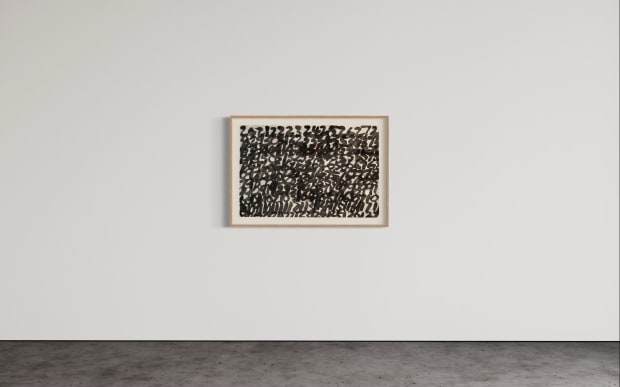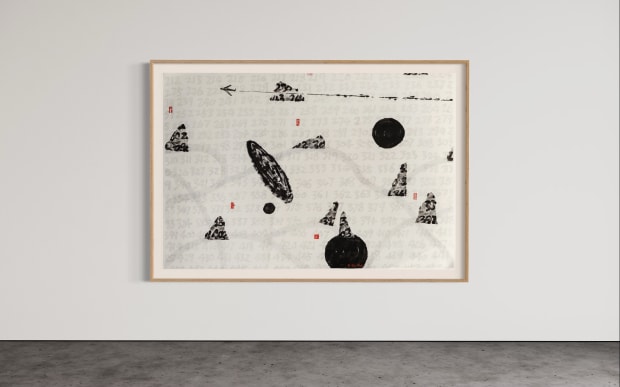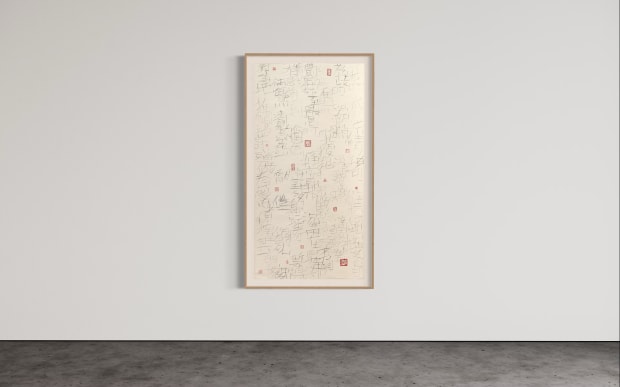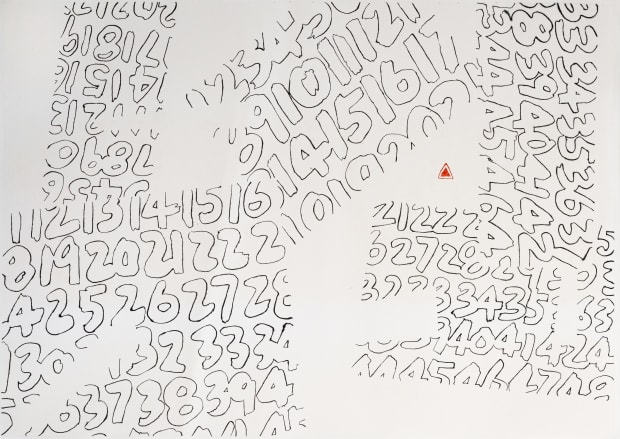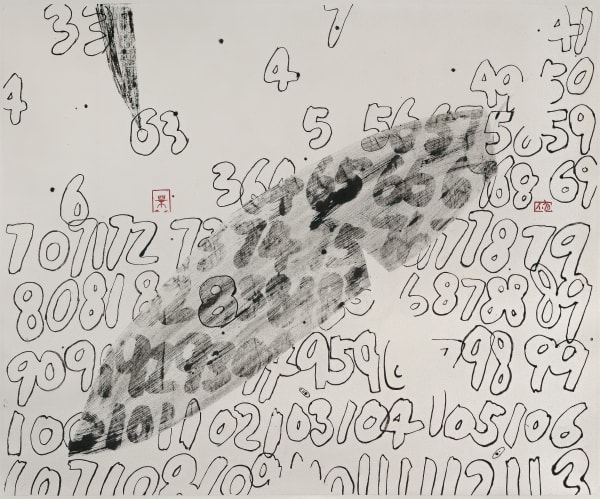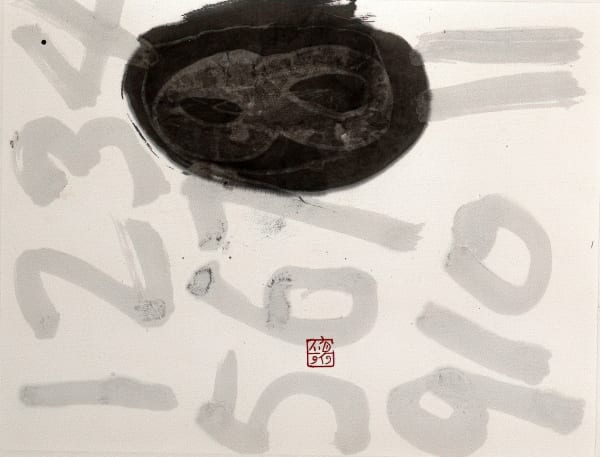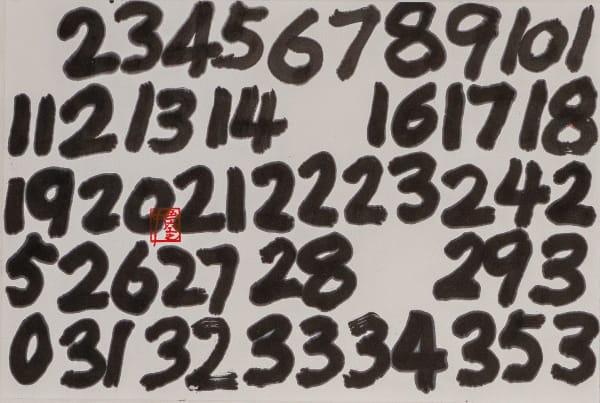-
 Post of the Exhibition
Post of the Exhibition -
-
-

-
I
Fung Ming Chip’s shufa is firmly grounded in traditional practice. Beginning in the 1970s, Fung achieved mastery of traditional shufa by copying the brushwork and composition of classical works and integrating them into his art. For Fung, what distinguishes shufa from other art forms is its ability to faithfully record the process of its creation. In his Shufa Sutra (2015), Fung explains this idea by defining shufa as the “art of time.” Works of traditional shufa are legible records of the actions that created them, allowing viewers to follow each brushstroke, in sequence, from start to finish.
-
 Fung Ming Chip, Couplet in Seal Script, 篆书对联, 1981, Signed, Ink on Paper, Each 47 x 12 in (2)
Fung Ming Chip, Couplet in Seal Script, 篆书对联, 1981, Signed, Ink on Paper, Each 47 x 12 in (2) -
II
Can shufa serve as a record of time when its connection to writing breaks down? In a range of works that date from the early 1980s to the present, Fung uses the traditional tools of brush, ink, and paper in new ways, creating “scripts” that push the boundaries of legibility. Despite their varied appearance, these scripts are united by their common meditation on time and process. Reading these works layer by layer, a viewer can trace Fung’s artistic process, even without being versed in traditional Chinese modes of viewership. -
 Fung Ming Chip, Piled Needle Script, 针直叠字, 2001, Ink on Paper, 54 x 27 in
Fung Ming Chip, Piled Needle Script, 针直叠字, 2001, Ink on Paper, 54 x 27 in
-
-
 Fung Ming Chip, Transition Script, 变化字, 2022, Signed, Ink on Paper, 13 3/4 x 51 1/8 in
Fung Ming Chip, Transition Script, 变化字, 2022, Signed, Ink on Paper, 13 3/4 x 51 1/8 in
-
 Fung Ming Chip, Music Script, 音乐字 , Signed, Ink on Paper, 54 x 27 1/2 in (137.2 x 69.8 cm)
Fung Ming Chip, Music Script, 音乐字 , Signed, Ink on Paper, 54 x 27 1/2 in (137.2 x 69.8 cm) -
III
Beginning in the 1990s, Fung began to experiment with processes that embed time in shufa in new ways. He has built layers of texture by using baths of ink and water, by layering paper, and even by excising text with razor blades. Though these processes break from the conventions that define traditional shufa practice, these works explore how layers of creation can be clearly encoded into the flat surface of a static work, making the chronological sequence of Fung’s practice legible to viewers.
-
 Fung Ming Chip, Rubbing Script, 拓字, 2017, Ink on Paper, 24 x 48 in
Fung Ming Chip, Rubbing Script, 拓字, 2017, Ink on Paper, 24 x 48 in -
 Fung Ming Chip, Mixed Scripts, 混合字, 2015, Signed, Ink on Paper, 24 x 48 in (61 x 122 cm)
Fung Ming Chip, Mixed Scripts, 混合字, 2015, Signed, Ink on Paper, 24 x 48 in (61 x 122 cm) -
IV
In 2002, Fung Ming Chip started experimenting with the ideas and processes that evolved into NumberS Series by incorporating Arabic numbers and dates into his art. Five years later, he realized that numbers, like Chinese characters, hold the power to represent sequences of time. In his first exhibition of NumberS Series in 2015, Fung wrote sequences of dates and binary code using both traditional brushwork and mechanical processes. These works pushed the boundaries of shufa, distancing his practice from a purely literary mode of expression and aligning it more closely with ink painting. In his latest works from NumberS Series, Fung combines visual representations and perspectival rendering with his unique approach to shufa to create new possibilities for expression while drawing elements from both traditions.
-
 Fung Ming Chip, NumberS: Form Vacant Script II, 数字系列:定型空心字(二), 2022, Ink on Paper, 27 x 38 1/4 in
Fung Ming Chip, NumberS: Form Vacant Script II, 数字系列:定型空心字(二), 2022, Ink on Paper, 27 x 38 1/4 in
-
-
 Fung Ming Chip, NumberS: Transparent Script with Pagoda, 数字系列:宝塔透字, 2022, Ink on Paper, 27 1/8 x 56 1/4 in
Fung Ming Chip, NumberS: Transparent Script with Pagoda, 数字系列:宝塔透字, 2022, Ink on Paper, 27 1/8 x 56 1/4 in
-
-
NumberS: Shadow Script with Excision, 数字系列:留空影字
The sequence of Fung’s artistic process is embedded in the layers of this work. First, he wrote a series of numbers in light grey ink before quickly painting over them with a brush loaded with dark grey ink. The interaction between these two shades of wet ink makes the numbers spread and “bloom” where the dark ink is thickest. The last few strokes of this upper layer were applied as the brush ran out of ink, leaving brushy streaks that produce a different effect. Next, Fung used a razor blade to excise arrow shapes from the paper, pointing to elements of the layers beneath. Finally, he finished the work by affixing a seal with his name squarely in the center. Thus, while the formal elements seem balanced and strictly two-dimensional, the work may be read as a record of Fung’s artistic process unfolding in time. -
Fung Ming Chip
-
-
 Fung Ming Chip, NumberS: Form Mixed Scripts I, 数字系列:定型混合字(一), 2022
Fung Ming Chip, NumberS: Form Mixed Scripts I, 数字系列:定型混合字(一), 2022 -
 Fung Ming Chip, NumberS: Form Vacant Script II, 数字系列:定型空心字(二), 2022
Fung Ming Chip, NumberS: Form Vacant Script II, 数字系列:定型空心字(二), 2022 -
 Fung Ming Chip, Couplet in Seal Script, 篆书对联, 1981
Fung Ming Chip, Couplet in Seal Script, 篆书对联, 1981 -
 Fung Ming Chip, NumberS: Form Transparent Script II, 数字系列:定型透字(二), 2022
Fung Ming Chip, NumberS: Form Transparent Script II, 数字系列:定型透字(二), 2022 -
 Fung Ming Chip, NumberS: Transparent Script with Exicison, 数字系列:留空透字, 2021
Fung Ming Chip, NumberS: Transparent Script with Exicison, 数字系列:留空透字, 2021 -
 Fung Ming Chip, NumberS: Form Mixed Scripts II, 数字系列:定型混合字(二), 2022
Fung Ming Chip, NumberS: Form Mixed Scripts II, 数字系列:定型混合字(二), 2022 -
 Fung Ming Chip, NumberS: Vacant Script 72 II, 数字系列:空心字72(二), 2021
Fung Ming Chip, NumberS: Vacant Script 72 II, 数字系列:空心字72(二), 2021 -
 Fung Ming Chip, NumberS: Vacant Script 72 I, 数字系列:空心字72(一), 2022
Fung Ming Chip, NumberS: Vacant Script 72 I, 数字系列:空心字72(一), 2022 -
 Fung Ming Chip, NumberS: Sand Script, 数字系列:沙字, 2022
Fung Ming Chip, NumberS: Sand Script, 数字系列:沙字, 2022 -
 Fung Ming Chip, NumberS: Mixed Scripts, 数字系列:混合字, 2022
Fung Ming Chip, NumberS: Mixed Scripts, 数字系列:混合字, 2022 -
 Fung Ming Chip, NumberS: Mixed Scripts with Stars and Clouds, 数字系列:星云混合字, 2016
Fung Ming Chip, NumberS: Mixed Scripts with Stars and Clouds, 数字系列:星云混合字, 2016 -
 Fung Ming Chip, NumberS: Transparent Script with Pagoda, 数字系列:宝塔透字, 2022
Fung Ming Chip, NumberS: Transparent Script with Pagoda, 数字系列:宝塔透字, 2022 -
 Fung Ming Chip, NumberS: Secret Script, 数字系列:秘字, 2021
Fung Ming Chip, NumberS: Secret Script, 数字系列:秘字, 2021 -
 Fung Ming Chip, NumberS: Shadow Script with Excision, 数字系列:留空影字, 2021
Fung Ming Chip, NumberS: Shadow Script with Excision, 数字系列:留空影字, 2021 -
 Fung Ming Chip, NumberS: Transparent Script ∞, 数字系列:透字∞, 2022
Fung Ming Chip, NumberS: Transparent Script ∞, 数字系列:透字∞, 2022 -
 Fung Ming Chip, NumberS: Transparent Script 72, 数字系列:透字72, 2022
Fung Ming Chip, NumberS: Transparent Script 72, 数字系列:透字72, 2022 -
 Fung Ming Chip, Music Script, 音乐字
Fung Ming Chip, Music Script, 音乐字 -
 Fung Ming Chip, NumberS: Form Vacant Script I, 数字系列:定型空心字(一), 2022
Fung Ming Chip, NumberS: Form Vacant Script I, 数字系列:定型空心字(一), 2022 -
 Fung Ming Chip, NumberS: The Sequence, 数字系列:序列, 2022
Fung Ming Chip, NumberS: The Sequence, 数字系列:序列, 2022 -
 Fung Ming Chip, Piled Needle Script, 针直叠字, 2001
Fung Ming Chip, Piled Needle Script, 针直叠字, 2001 -
 Fung Ming Chip, Rubbing Script, 拓字, 2017
Fung Ming Chip, Rubbing Script, 拓字, 2017 -
 Fung Ming Chip, Transition Script, 变化字, 2022
Fung Ming Chip, Transition Script, 变化字, 2022 -
 Fung Ming Chip, Time Script, 顺时字, 2019
Fung Ming Chip, Time Script, 顺时字, 2019
-
Curated by Dr. Daniel Greenberg, 17 March - 20 May 2023
Join our mailing list
* denotes required fields
We will process the personal data you have supplied to communicate with you in accordance with our Privacy Policy. You can unsubscribe or change your preferences at any time by clicking the link in our emails.



